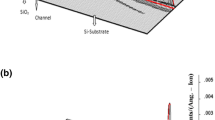Abstract
The total dose effect of 60Co γ-rays on 0.8-μm H-gate partially depleted-silicon-on-insulator NMOS devices was investigated at different irradiation doses. The results show that the shift in saturation current at high dose rate is greater than that at low dose rate, due to increase in interface-state density with decreasing dose rate; the scattering effect of interface state on electrons in the channel causes degradation in carrier mobility; and the body current and transconductance of the back gate enhance low-dose-rate sensitivity when the irradiation is under OFF-bias. A double transconductance peak is observed at 3 kGy(Si) under high dose rates.





Similar content being viewed by others
References
S.S. Rathod, A.K. Saxena, S. Dasgupta, Alpha-particle-induced effects in partially depleted silicon on insulator devices: with and without contact. IET Circuits Devices Syst. 5, 52–58 (2011). doi:10.1049/iet-cds.2010.0080
N. Vinodhkumar, Y.V. Bhuvaneshwari, K.K. Nagaraian et al., Heavy-ion irradiation study in SOI-based and bulk-based junctionless FinFETs using 3D-TCAD simulation. Microelectron. Reliab. 55, 2647–2653 (2015). doi:10.1016/j.microrel.2015.09.011
J.X. Lou, J. Chen, Z. Chai et al., Total dose effects in tunnel-diode body-contact SOI nMOSFETs. IEEE Trans. Nucl. Sci. 61, 3018–3022 (2014). doi:10.1109/TNS.2014.2364923
C. Peng, Z.Y. Hu, B.X. Ning et al., Radiation-enhanced gate-induced-drain-leakage current in the 130 nm partially-depleted SOI pMOSFET. Solid State Electron. 106, 81–86 (2015). doi:10.1016/j.sse.2015.01.023
X. Wu, W. Lu, X. Wang et al., Influence of channel length and layout on TID for 0.18 μm NMOS transistors. Nucl. Sci. Tech. 24, 060202–060206 (2013). doi:10.13538/j.1001-8042/nst.2013.06.019
L.L. Li, Z.G. Yu, Z.Q. Xiao et al., Threshold voltage degradation mechanism of SOI SONOS EEPROM under total-dose irradiation. Acta Phys. Sinica (2011). doi:10.7498/aps.60.098502. (in Chinese)
F. Tan, R. Huang, X. An et al., Total ionizing dose (TID) effect and single event effect (SEE) in quasi-SOI nMOSFETs. Semicond. Sci. Technol. 29, 15010–15016 (2014). doi:10.1088/0268-1242/29/1/015010
H.X. Huang, Y.Y. Huang, J.C. Zheng et al., Hardening silicon-on-insulator nMOSFETs by multiple-step Si + implantation. Microelectron. Reliab. 57, 1–9 (2016). doi:10.1016/j.microrel.2015.12.015
I. Kurachi, K. Kobayashi, M. Mochizuki et al., Tradeoff between low-power operation and radiation hardness of fully depleted SOI pMOSFET by changing LDD conditions. IEEE Electron Dev. Lett. 63(6), 2293–2298 (2016). doi:10.1109/TED.2016.2552486
M. Asano, D. Sekigawa, K. Hara et al., Characteristics of non-irradiated and irradiated double SOI integration type pixel sensor. Nucl. Instrum. Methods Phys. Res. Sect. Accel. Spectrom. Detect. Assoc. Equip. 831, 315–321 (2016). doi:10.1016/j.nima.2016.03.095
B.P. He, Z.B. Yao, J.K. Sheng et al., Study of the dose rate effect of 180 nm nMOSFETs. Chin. Phys. C (2015). doi:10.1088/1674-1137/39/1/016004
V.D. Popov, Two stages of surface-defect formation in a MOS Structure under low-dose rate gamma irradiation. Semiconductors 50, 349–351 (2016). doi:10.1134/S1063782616030209
D.M. Fleetwood, Total ionizing dose effects in MOS and low-dose-rate-sensitive linear-bipolar devices. IEEE Trans. Nucl. Sci. 60(3), 1706–1730 (2013). doi:10.1109/TNS.2013.2259260
P.C. Adell, B. Rax, I.S. Esqueda et al., Hydrogen limits for total dose and dose rate response in linear bipolar circuits. IEEE Trans. Nucl. Sci. 62, 2476–2481 (2015). doi:10.1109/TNS.2015.2500198
V.S. Pershenkov, A.S. Bakerenkov, V.S. Felitsyn et al., ELDRS in SiGe transistors for room and low-temperature irradiation. Microelectron. Reliab. 63, 56–59 (2016). doi:10.1016/j.microrel.2016.05.010
J. Boch, A. Michez, M. Rousselet et al., Dose rate switching technique on ELDRS-free bipolar devices. IEEE Trans. Nucl. Sci. (2016). doi:10.1109/TNS.2015.2512620
B.P. He, G.Z. Wang, H. Zhou et al., Predicting NMOS device radiation response at different dose rates in γ ray environment. Acta Phys. Sinica 52, 188–191 (2003). (in Chinese)
B. Lan, Q. Guo, J. Sun et al., Dose-rate effects of p-channel metal oxide semiconductor field-effect transistors at various biasing conditions. J. Semicond. (2010). doi:10.1088/1674-4926/31/5/054004
J. Alvarado, E. Boufouss, V. Kilchytska et al., Compact model for single event transients and total dose effects at high temperatures for partially depleted SOI MOSFETs. Microelectron. Reliab. 50, 1852–1856 (2010). doi:10.1016/j.microrel.2010.07.040
S.N. Rashkeev, C.R. Cirba, D.M. Fleetwood et al., Physical model for enhanced interface-trap formation at low dose rates. IEEE Trans. Nucl. Sci. 49, 2650–2655 (2002). doi:10.1109/TNS.2002.805387
H.P. Hjalmarson, R.L. Pease, R.A.B. Devine et al., Calculations of radiation dose-rate sensitivity of bipolar transistors. IEEE Trans. Nucl. Sci. 55, 3009–3015 (2008). doi:10.1109/TNS.2008.2007487
S.E. Ivan, J.B. Hugh, C. Philippe et al., Modeling low dose rate effects in shallow trench isolation oxides. IEEE Trans. Nucl. Sci. 58, 2945–2952 (2011). doi:10.1109/TNS.2011.2168569
S.E. Ivan, J.B. Hugh, C. Philippe et al., Modeling the effects of hydrogen on the mechanisms of dose rate sensitivity. IEEE Trans. Nucl. Sci. 59, 701–706 (2012). doi:10.1109/RADECS.2011.6131290
C. Peng, Z.Y. Hu, B.X. Ning et al., Total-ionizing-dose induced coupling effect in the 130-nm PDSOI I/O nMOSFETs. IEEE Electron Dev. Lett. 35, 503–505 (2014). doi:10.1109/LED.2014.2311453
V. Ferlet-Cavrois, T. Colladant, P. Paillet et al., Worst-case bias during total dose irradiation of SOI transistors. IEEE Trans. Nucl. Sci. 47, 2183–2188 (2000). doi:10.1109/23.903751
N.J. Wang, Z.L. Liu, N. Li et al., Total dose irradiation of FD SOI NMOSFET under different bias configurations. J. Semicond. 28, 750–754 (2007). doi:10.3321/j.issn:0253-4177.2007.05.024. (in Chinese)
Acknowledgements
These sample irradiations were conducted in the 60Co Source at the Northwest Institute of Nuclear Technology. The authors thank Mr. Yao Zhi-Bin, Mr. He Bao-Ping, and their colleagues for their kind help in the experiments.
Author information
Authors and Affiliations
Corresponding authors
Additional information
This work was supported by the National Natural Science Foundation of China (No. 61376099), the Foundation for Fundamental Research of China (No. JSZL2016110B003) and the Major Fundamental Research Program of Shaanxi (No.2017ZDJC-26).
Rights and permissions
About this article
Cite this article
Wang, QQ., Liu, HX., Wang, SL. et al. Total ionizing dose effect of gamma rays on H-gate PDSOI MOS devices at different dose rates. NUCL SCI TECH 28, 151 (2017). https://doi.org/10.1007/s41365-017-0295-7
Received:
Revised:
Accepted:
Published:
DOI: https://doi.org/10.1007/s41365-017-0295-7




